Silver and Gold (Brayed Sallet of Pewter Prawn and Pike Caviar)
From country to city: a rural fisherman’s dish re-imagined as a refined urban delicacy
- Background
- Recipe
Diners first making the acquaintance of this modern Arlene high-table delicacy generally become too busy enjoying it to bother inquiring about its origins. But its refined appearance as served by the royal kitchens in Prydon to the King’s guests (or to casual passers-by, since Kynall Castle’s refectories are open to all) goes far to conceal its robust genesis as a fishermen’s dish of the coastal and riverine country between the eastern and western branches of the Upper Arlid.
The original version of what would later be known as “Silver and Gold” (Arl./N.Arl. Dekhen-u-Ihrsen) was devised by North Arlene prawn fishermen who needed to find a use for shellfish they’d caught that were too small or damaged to offer in the coastal markets of Fûrdéin and Asfahæg. These “subpar” shrimp would be boiled in brine abroad ship and then kept submerged in frequently-renewed seawater until the fishermen made port.
There the ocean shrimp-fishers would meet with their freshwater-fishing counterparts, some of whom would be bringing in new-landed starscale pike (and other types) from the broad and busy breeding grounds of the upper Arlid delta. Cooked salt-water prawns would readily enough be bartered for sweetwater pike and their fine-grained, golden roe—or acquired by taverners in the “borderer” port towns east and west of Rûl Tyn—and cooked together with them.
A popular longshoremen’s approach, because it kept well after cooking, was to mix and bind the chopped-up shrimps with grated dried bread and egg to make fish balls or thick cakes. These would be stuffed with chunks of roe from either marine or riverine fish—pike’s roe being a favorite for its buttery and slightly smoky flavor, and the roes sometimes being cooked separately first. Then the (sometimes) breaded fishcakes would be fried in whatever fat was regionally most plentiful.1 The fried cakes could afterward be served up in a number of ways: by themselves—though often dipped in savory sauces heavy on whitefruit—pressed onto bread trenchers or sippets and sauced on top, or wrapped in wheaten or oaten platebreads in the Darthene coastal style.
But later on, during the period in the mid-1900s p.A.d.2 when a series of dynastic and climatic disasters led the North Arlene crown to resign most of its major functions to the Arlene Throne, the nature of the dish (as of many others originally native to North Arlen) began to change. Late-century cooks in Prydon and other northern Arlene cities began to upscale North Arlene cuisine in general as a kind of culinary tribute to a kingdom in decline. In the process they transformed this coastline shellfish dish into a more sophisticated composition seen (correctly or incorrectly) as more suited to urban palates, and tailored to emphasize the fresh marine flavor of the prawns.
The dish’s modern name refers specifically to the classic Prydon-devised version in which the pale color of the meat of the shrimp is made to contrast strongly with the gold of pike caviar—in this presentation, now delicately rubbed out of the original “skeins” of roe to be served on top. And while we can certainly approach the flavor of the dish when making it on our own Earth, one thing we can’t approach is the perfect paleness of the Arlene versions.
This is because we lack a specific and vital ingredient: the Arlene pewter shrimp, Metacrangon peltrumis medioregnis. While otherwise generally similar to Crangon crangon, the common our-Earth north Atlantic “gray shrimp”, M. peltrumis is missing something normally commonplace among crustaceans: the protein complex called astaxanthin, which normally reacts with another complex called crustacyanin to produce the red shell and pinkish flesh coloration typical of cooked shrimps.3 As a result, the cooked flesh of the pewter shrimp is pure white, with no other colors to interfere with the shrimp’s silvery presentation on the plate.
These more citified versions of dekhen-u-ihrsen involve, somewhat paradoxically, less cooking but more labor. After peeling and deveining, the cooked and chopped pewter shrimp are crushed and pounded in a mortar… hence the term “brayed” in the recipe name. (This indicates that the mortared shrimp mixture has a consistency smoother than something knife-chopped, but nonetheless more textured than an otherwise-mechanically produced puree.) After the addition of soured cream and spices, the mixture is molded between spoons and chilled in an ice-room until it firms slightly, and then served forth on toasted sippets and topped with iced pike caviar.
The use of the term “sallet” in the recipe name harks back (in one linguistic direction) to our many uses for the word “salad“, and (in a different, more archaic one) to transitional early-1900s versions of the dish in which the pounded and formed shrimp was served out on roasted lettuce or cooked bitterleaf greens. In current versions, such as the one we illustrate here, greens are often still part of the presentation. But the main theme of the dish remains the contrast between the pale delicacy of the pounded shrimp and the glistening gold of the caviar.
See the tab above for the full recipe.
1 In North Arlen this would normally be sunflower, palm oil, or treenut oil (from the Middle Kingdoms version of our Shea tree, Vitellaria paradoxa).
2 The commonly-used abbreviation for pai Ajnedäre derüwin: “since the Arrival”—i.e. of the Dragons, and therefore since the destruction of the Dark.
3 More information on our Earth’s recent discovery of this chemical interaction can be found in this interesting paper.
A note before we start: Pike caviar is fortunately easier to get hold of than it used to be… not to mention a lot less expensive. But we can’t really suggest getting it from Petrossian, who it seems are charging more than one really needs to pay. The pike caviar we used for this recipe comes from the German company Lemberg, who source it from line-caught Baltic pike. (And thanks to our local supplier in Ireland, eatmorefish.ie, who got it for us at a pretty reasonable price.)
Leaving aside the issue of buying the caviar in a jar, pike roe can also be sourced more locally if you know someone who fishes for pike. The Intrepid Eater’s website goes into some detail on how to cure your own pike roe. (And also doesn’t have ads plastered into it after every paragraph, which frankly is a breath of fresh air.)
The ingredients:
- 2 pounds / 1 kg large cooked prawns
- 100g jar of pike caviar (or other caviar of your preference. Salmon caviar, or mullet caviar if you can get it, could work quite nicely with this)
- Zest and juice of one lemon
- 1/4 teaspoon ground white pepper or ground long pepper
- Large pinch of ground nutmeg
- Large pinch of ground mace
- 2-3 tablespoons of firm sour cream or creme fraiche
- 4-6 small slices of thinly sliced bread
- 2-3 tablespoons of butter or clarified butter for frying the bread
- Hot sauce to taste, if desired (Tabasco or similar)
- Chopped chives to garnish
The method:
Rinse, shell and devein the cooked shrimp.
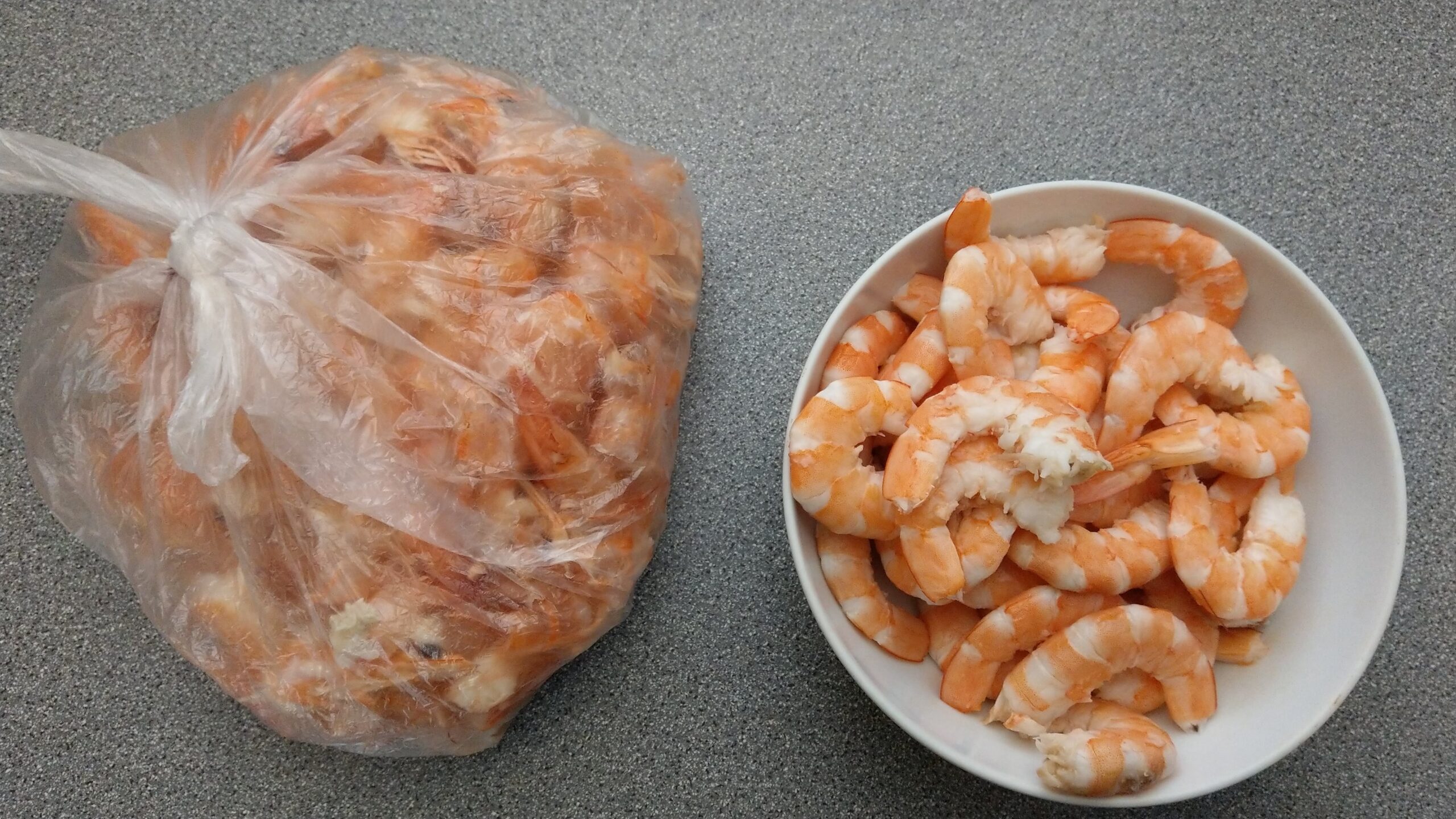 Set aside 4-6 of the shrimp to serve as a garnish in the final stages of the recipe. Chop all the remaining shrimp coarsely, and set half of the chopped shrimp aside.
Set aside 4-6 of the shrimp to serve as a garnish in the final stages of the recipe. Chop all the remaining shrimp coarsely, and set half of the chopped shrimp aside. 
Put the other half of the shrimp into a mortar and start crushing and mashing the chopped pieces into a paste. This is going to take a while, so you may want to take a few breaks during the process. (Adding a little of the lemon juice may help speed it up.)

If you don’t have a mortar and pestle but do have a food processor or food mill, that’s what you will want to fall back onto at this stage. But when processing or milling this first mixture, be careful to pulse or mill only sparingly. You don’t want an entirely smooth puree; there should be some texture left in the mixture before you begin the next stage.
Below you can see the kind of consistency you’re aiming for.
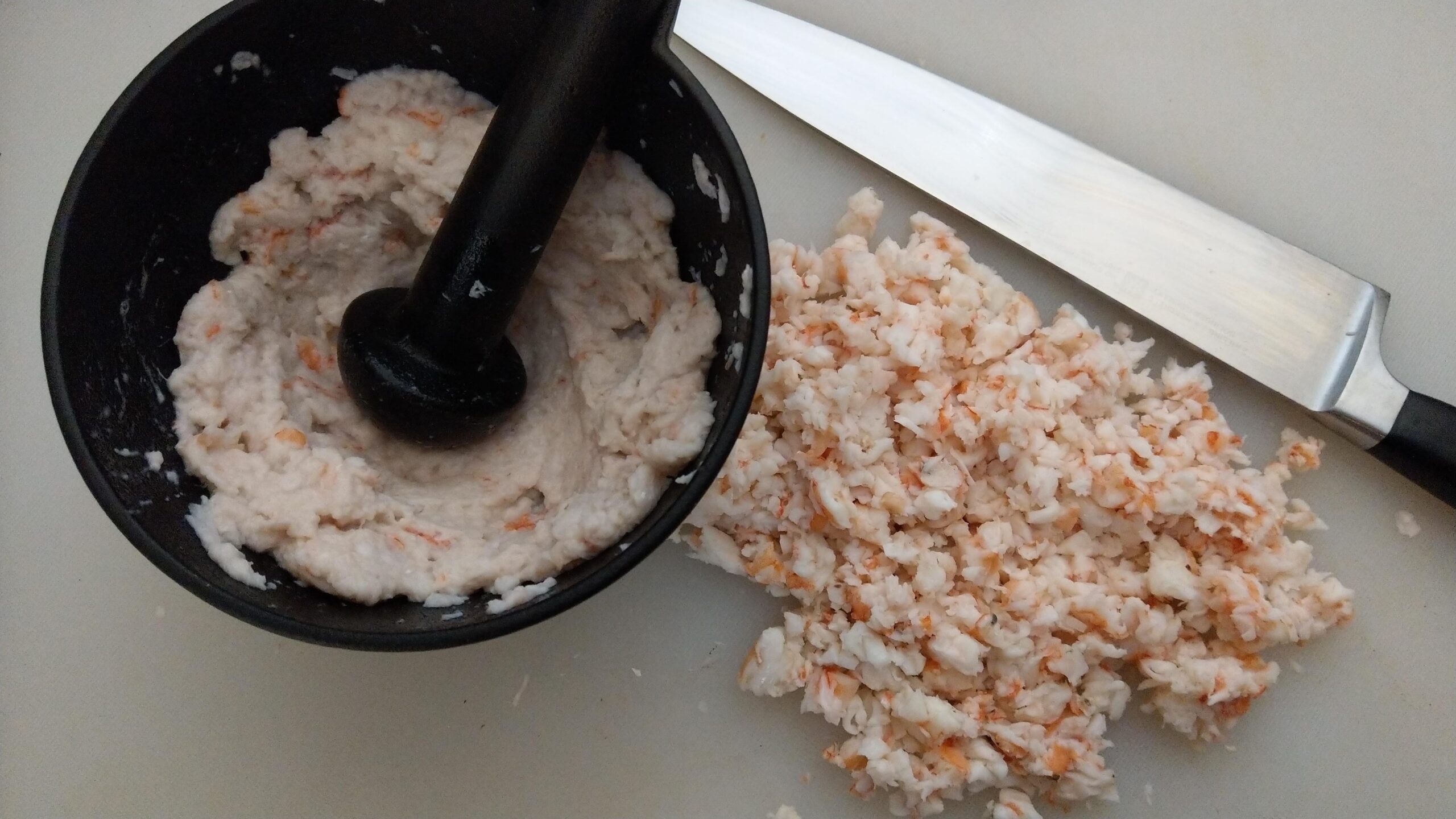
Now it’s time to start adding seasonings. For the basic version of the dish, add the lemon juice, lemon zest, salt, nutmeg, mace, hot sauce (if you want any: the addition would definitely be in line with some Middle Kingdoms versions that call for chiles like whitefruit), and white pepper or long pepper. Add the chopped shrimp and mix very well.
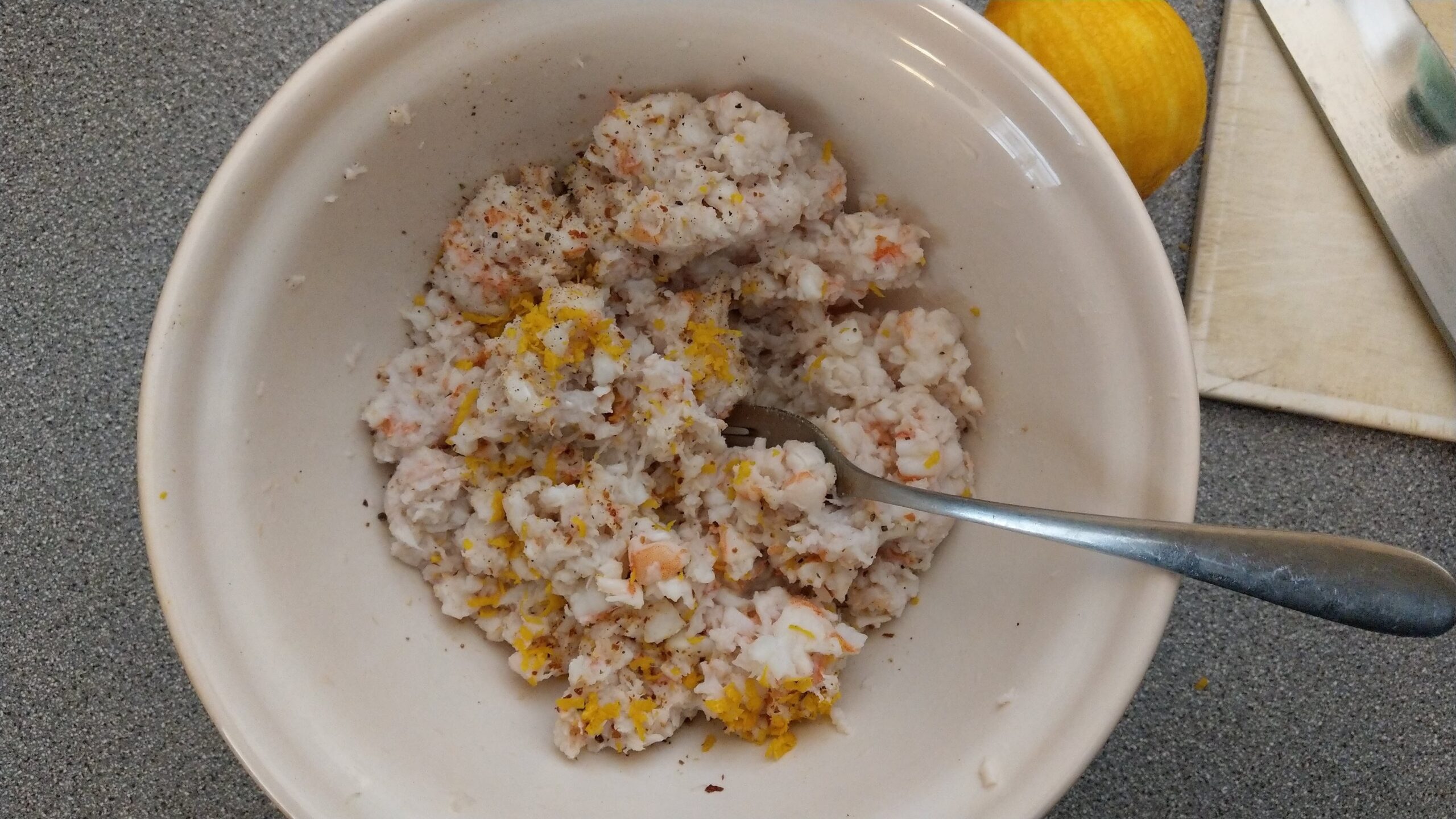
Set this mixture aside for a bit and deal with whatever you’re going to present the shrimp mixture on. In our case, this was little oval slices of bread, fried as for croutons.
If I was in the US, and had access to it, despite the fact that it doesn’t seem to have been oval-shaped for a while, I would have gone for Pepperidge Farm’s party/cocktail rye bread. (Which they may have stopped making? Google seems equivocal on this issue.) But since I don’t have access to it, the day before I started shooting this recipe, I baked a couple of baguettes using our household bread recipe…
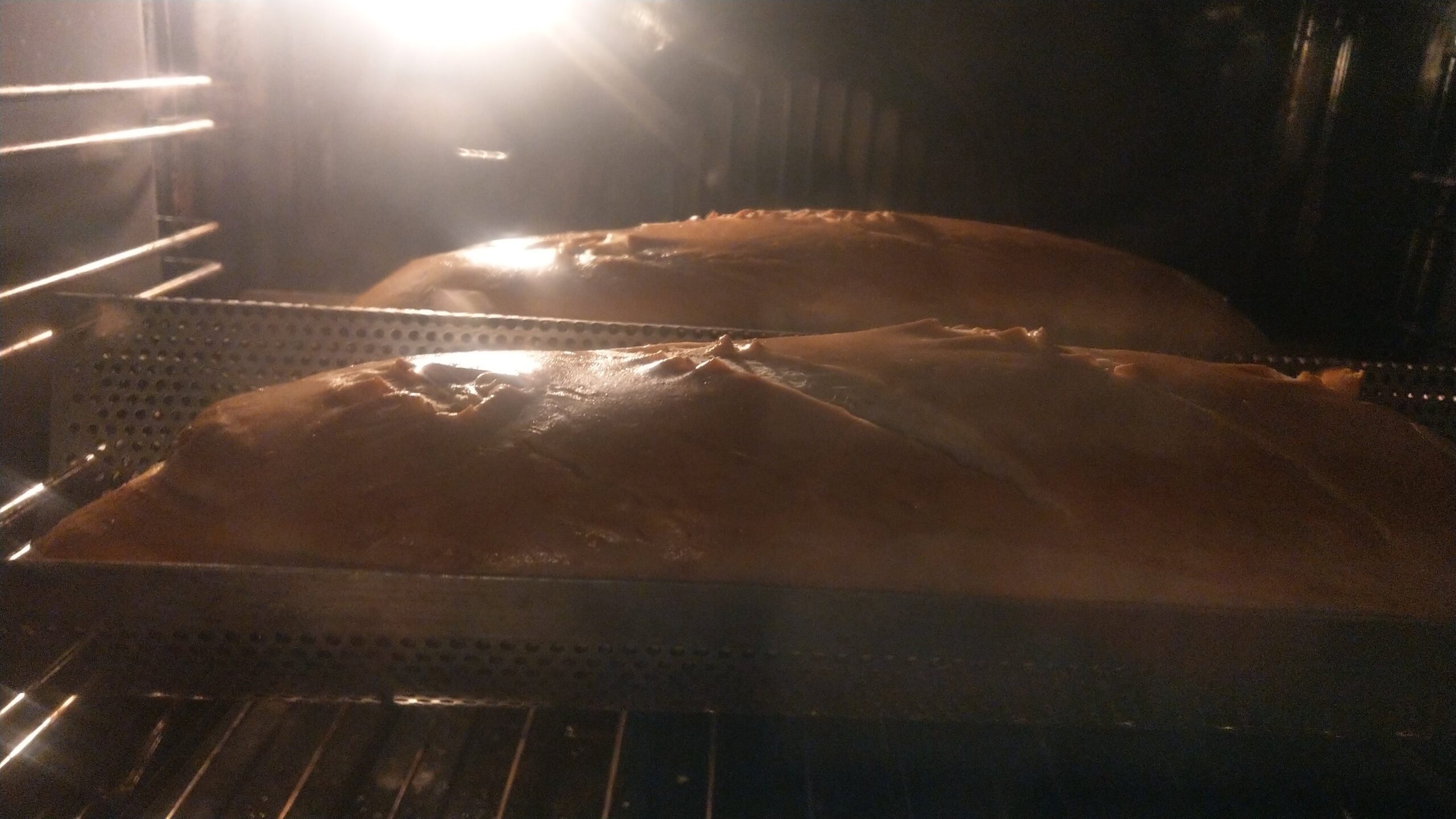
…and sliced them up: then fried the slices in clarified butter, and set them aside. (If you decide to go this route, you could also just toast them. But my experience suggests that frying renders the bread more resistant to the moisture in the shrimp mixture, and helps keep them crisp.)
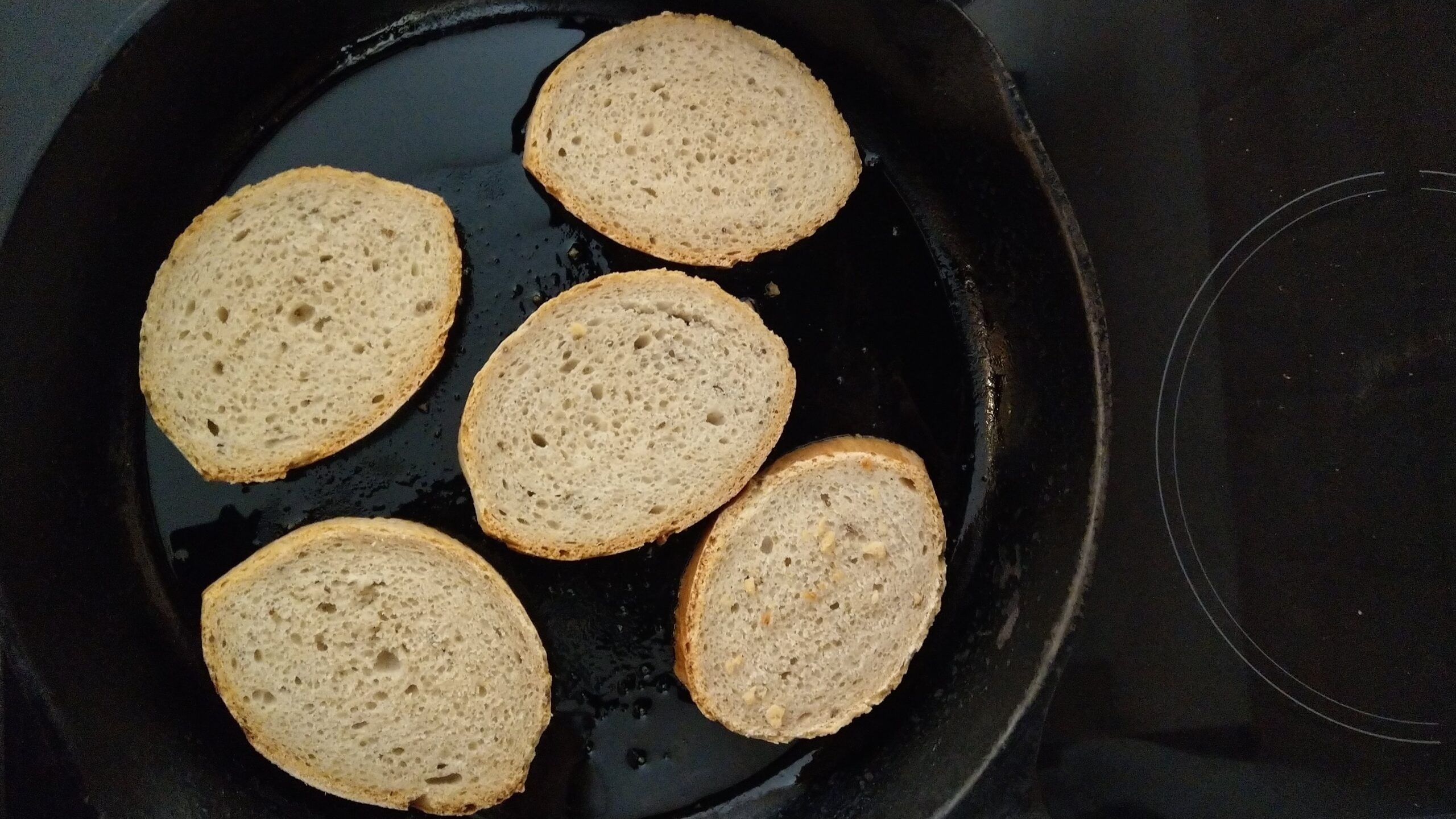
When the croutons (or other bases for presentation) are ready, add a couple of large tablespoonfuls of creme fraiche or a very firm sour cream to the shrimp mixture, and mix it well in. Then use a couple of tablespoons to form the shrimp mixture into plump ovals or rounds, and place them on the croutons.
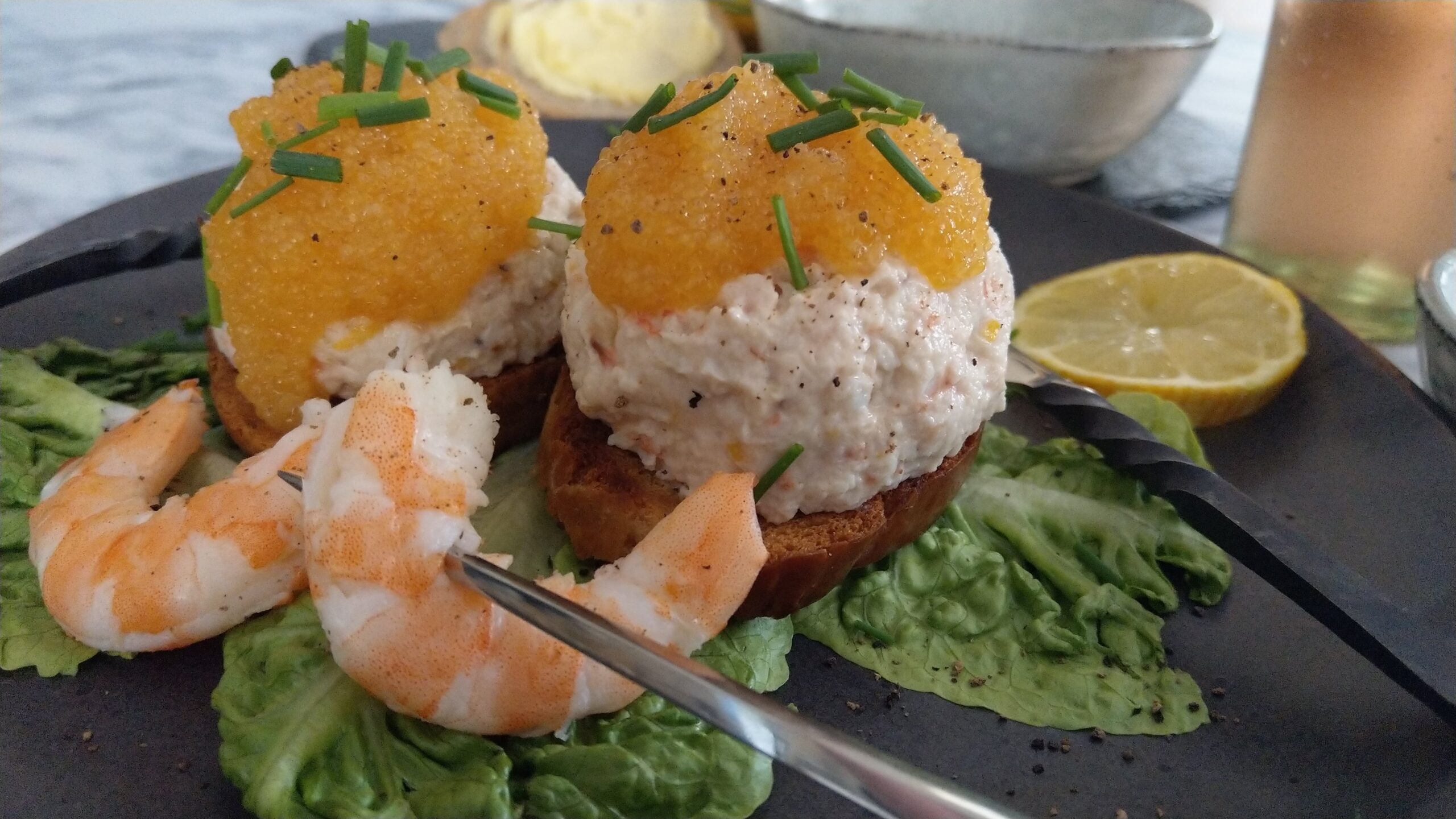
After that, ornament the shrimp with as much pike caviar as your taste dictates. You might also like to spoon a little more sour cream over before you garnish each piece with a whole shrimp, or some chopped chives. (Or serve the whole shrimp on the side.) Serving more slices of buttered bread on the side is also a good idea, for those who’d like to spread the shrimp and caviar on them; and some extra pike caviar in a bowl, for those who want more of that.
Enjoy!
Fish, shellfish, seafood



